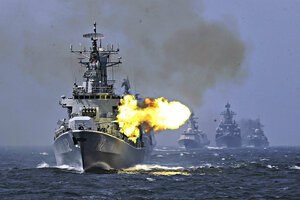Why China is slowing military spending
Chinese officials announced that military budget increases in the next national budget will be significantly lower than past years, despite increased tensions in the South China Sea.

China's Harbin (112) guided missile destroyer takes part in a week-long China-Russia "Joint Sea-2014" navy exercise at the East China Sea off Shanghai, China in 2014.
Color China Photo/AP/File
China will slow its military spending for the first time in half a decade, according to Fu Ying, a spokeswoman for China’s National People’s Congress.
This year’s military spending will increase by seven or eight percent, says Ms. Fu, far less than the double digit increases reported in previous years. She did not, however, say precisely how much the Chinese government would allocate for military spending.
China’s national budget report, which will be released on Saturday, will show just how much China plans to spend on its military this year, and how that spending compares to spending in other sectors of the economy.
The change comes at the same time that China is ramping up its military presence in the South China Sea due to territorial disputes in the area.
What does it mean that China chose to slow spending?
“Obviously it shows that China wants to demonstrate to the West, including the US and the neighboring countries that it has disputes with, that China sincerely wants to solve the problems through peaceful means,” Shanghai University political science professor Ni Lexiong told The Washington Post. “But the second reason is that China’s economy is bad indeed.”
China’s gross domestic product (GDP) grew just under seven percent in 2015, the slowest growth the Asian giant has experienced in 25 years.
Economists and officials are no more optimistic about the coming year, predicting that growth rates will continue to be sluggish.
Military spending experts told The New York Times that China is well aware that military spending can sink a country, pointing to the Soviet Union as an example.
Others, such as Renmin University professor Jin Canrong, say that the decreased emphasis on military spending could be due to social concerns. Dr. Canrong told the Times that China’s economic troubles made welfare spending a priority for the government.
Retired Chinese Gen. Xu Guangyu said that military spending has also likely dipped due to modernization slowdowns. When Chinese weapons technology modernizes, he says, military spending in that area will likely increase as well.
China’s modernization plans also means that China is moving towards funding a cybersecurity project, as well as air and sea forces over its traditional land based army. A study conducted by the Rand Corporation last year identified weaknesses in China’s modernization levels and military capabilities.
The decision to keep military spending increases down was still a surprise for several, due to the state of China’s military expansion in the South China Sea. Mr. Ni, for example, anticipated budget increases twice the amount that the National People’s Congress announced on Friday.
Yet, China would be by no means left defenseless by the change. The Chinese military remains the largest standing army in the world, with over two million soldiers.
US Naval War College professor Andrew Erickson told the Wall Street Journal that China’s budget decisions simply indicated a desire to walk a thin line between over-spending and maintaining military control.
“Beijing’s latest defense spending figure shows that it is determined to avoid Soviet-style military overextension,” said Erickson, “yet remains focused on enhancing capabilities to further its outstanding island and maritime claims in the East and South China seas.”
China’s activities in the region have incensed several area countries that have competing claims on South China Sea islands, as well as the United States, which sees millions of dollars worth of trade pass through the Sea.
China’s construction of surface to air missile batteries, among other military installations, prompted the United States to dispatch what it calls a “routine Naval patrol” to the South China Sea. The USS John C. Stennis, an aircraft carrier, is en route to the area, alongside a cruiser and two destroyers, according to Navy officials.
China has deemed such US patrols provocative. The United States says the same of Chinese military expansion on natural and constructed South China Sea islands.
“America made an important decision, which is deploying over 60 percent of its navy to the Asia-Pacific region,” said Fu at a press conference on Friday. “[The US] is strengthening military deployments with its alliances in the Asia-Pacific region. If we’re talking about militarization, what’s this? Isn’t it militarization?”


